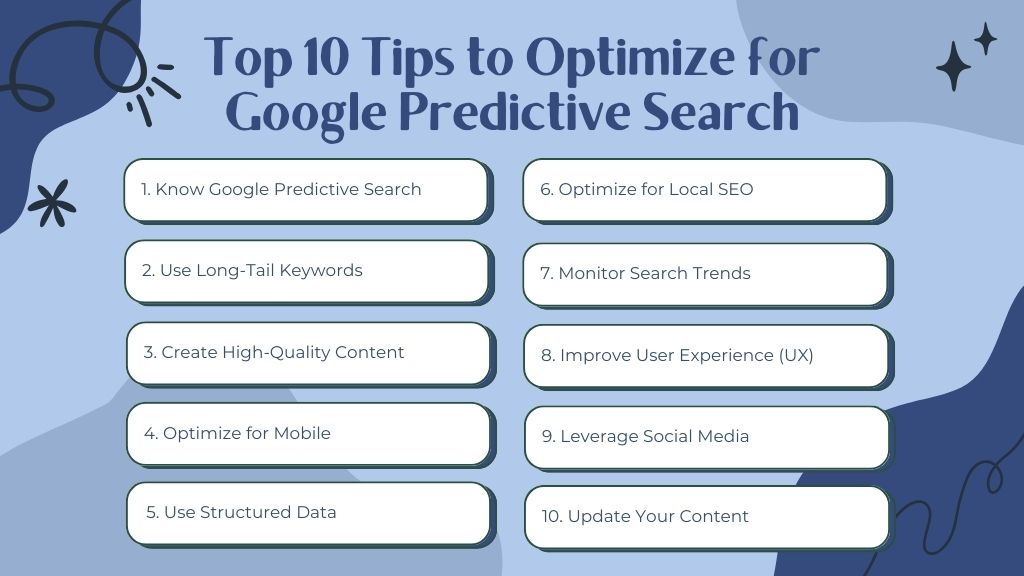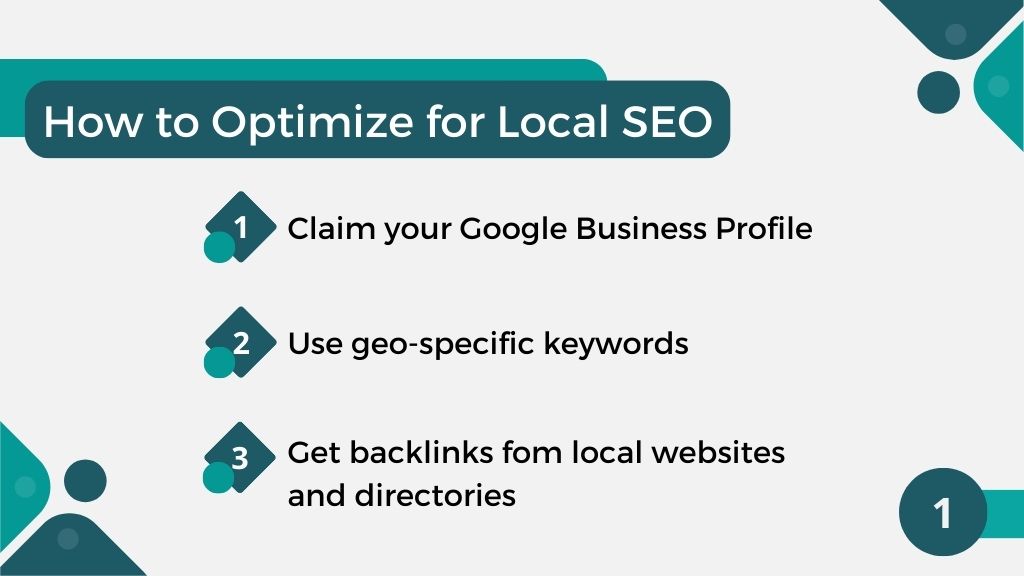Top 10 Tips to Optimize for Google Predictive Search

Google Predictive Search, also known as Google Autocomplete, helps users find information quickly by suggesting search queries as they type. Optimizing for this feature can drive more traffic to your site and improve your SEO.
In this article:
- Understand How Google Predictive Search Works
- Use Long-Tail Keywords
- Create High-Quality Content
- Optimize for Mobile
- Use Structured Data
- Optimize for Local SEO
- Monitor Search Trends
- Improve User Experience (UX)
- Leverage Social Media
- Update Your Content
1. Understand How Google Predictive Search Works
What Is Google Predictive Search?
Google Predictive Search suggests search queries based on popular searches, your search history, and your location. It’s designed to save users time by predicting what they are looking for.
Why It Matters
When your website appears in these predictions, it can attract more clicks and traffic. Understanding the mechanics behind it is the first step toward optimization.
2. Use Long-Tail Keywords
What Are Long-Tail Keywords?
Long-tail keywords are longer, more specific search phrases. For example, instead of “shoes,” a long-tail keyword might be “best running shoes for flat feet.”
How They Help
Long-tail keywords often match the precise queries users type into Google. By targeting these, you increase your chances of appearing in Google Predictive Search suggestions.
Action Steps
- Research Keywords: Use tools like Google Keyword Planner, Ahrefs, or SEMrush to find relevant long-tail keywords.
- Incorporate Them Naturally: Include these keywords in your content, titles, and meta descriptions without keyword stuffing.
3. Create High-Quality Content
What Is High-Quality Content?
High-quality content is informative, well-written, and relevant to your audience. It should answer questions and provide value.
How It Helps
Google favors high-quality content from authority sites because it wants to provide users with the best possible search results. If your content is top-notch, it’s more likely to be suggested in predictive searches.
Action Steps
- Write Thorough Articles: Cover topics in-depth and answer common questions.
- Update Regularly: Keep your content fresh and up-to-date.
- Engage Your Audience: Use multimedia, such as images and videos, to make your content more engaging.

4. Optimize for Mobile
Why Mobile Optimization Is Important
More people are using mobile devices to search the web than ever before, with 64% of searches coming from smartphones. Google uses mobile-first indexing, which means it primarily uses the mobile version of a site for ranking and indexing.
How It Helps
A mobile-friendly site is more likely to rank higher in search results, including predictive searches.
Action Steps
- Responsive Design: Ensure your site adjusts to different screen sizes.
- Fast Load Times: Compress images and use caching to speed up your site.
- Easy Navigation: Make sure users can easily navigate your site on a mobile device.
5. Use Structured Data
What Is Structured Data?
Structured data is a standardized format for providing information about a page and classifying the page content. It helps search engines understand your content better.
How It Helps
Structured data can enhance your search results with rich snippets, making your site more attractive in search results and potentially in predictive searches.
Action Steps
- Add Schema Markup: Use schema.org to find relevant structured data markup for your content.
- Test Your Markup: Use Google’s Structured Data Testing Tool to ensure your markup is correct.

6. Optimize for Local SEO
What Is Local SEO?
Local SEO focuses on optimizing your website to rank better for a local audience. This includes using location-specific keywords and setting up your Google Business profile.
How It Helps
Local SEO helps your business appear in location-based searches and predictions, which is crucial for attracting nearby customers.
Action Steps
- Google Business Profile: Claim and optimize your Google Business listing.
- Local Keywords: Use keywords that include your location to show up in the Google Local Pack.
- Local Backlinks: Get backlinks from local websites and directories.
7. Monitor Search Trends
Why Monitor Search Trends?
Search trends show what people are currently interested in. By staying on top of these trends, you can create content that meets current demand.
How It Helps
Creating content around trending topics, including seasonal keyword trends, increases your chances of appearing in predictive search suggestions.
Action Steps
- Google Trends: Use Google Trends to see what people are searching for.
- Seasonal Content: Plan content around seasonal trends and events.
- Industry News: Stay updated on news and trends in your industry.

8. Improve User Experience (UX)
What Is User Experience?
User experience refers to how users interact with your website. A good UX means your site is easy to use and provides a pleasant experience.
How It Helps
A positive user experience can lead to higher engagement and lower bounce rates, which Google considers when ranking sites.
Action Steps
- Simple Navigation: Make it easy for users to find what they’re looking for.
- Clean Design: Use a clean and professional design that’s easy on the eyes.
- Interactive Elements: Include interactive elements like buttons and forms that work smoothly.
9. Leverage Social Media
Why Social Media Matters
Social media platforms can drive social traffic to your site and increase brand awareness. Shares, likes, and comments can also indirectly affect your SEO.
How It Helps
Content that gets shared on social media is more likely to be noticed by Google and included in predictive search suggestions.
Action Steps
- Share Content: Regularly share your content on social media platforms.
- Engage Followers: Respond to comments and interact with your audience.
- Social Media Ads: Use targeted ads to reach a broader audience.
10. Update Your Content
Why Regular Updates Are Important
Search engines favor websites that are updated regularly. Fresh content signals to Google that your site is active and relevant.
How It Helps
Regularly updated content is more likely to be included in search predictions because it’s current and relevant.
Action Steps
- Content Calendar: Create a content calendar to schedule regular updates.
- Revise Old Content: Update and improve old content to keep it relevant.
- Add New Information: Continuously add new information to your site to keep it fresh.
Stay Ahead in SEO
Optimizing for Google Predictive Search can significantly boost your website’s visibility and traffic. By understanding how predictive search works and implementing these top 10 tips, you can improve your chances of appearing in Google’s autocomplete suggestions.
Pair your on-page SEO efforts, like optimizing for predictive search, with off-page SEO campaigns, like link building. Link Genius is designed to simplify your outreach and build authority efficiently for a holistic approach to SEO.
Book a demo today and see how Link Genius can help streamline your link building process.
